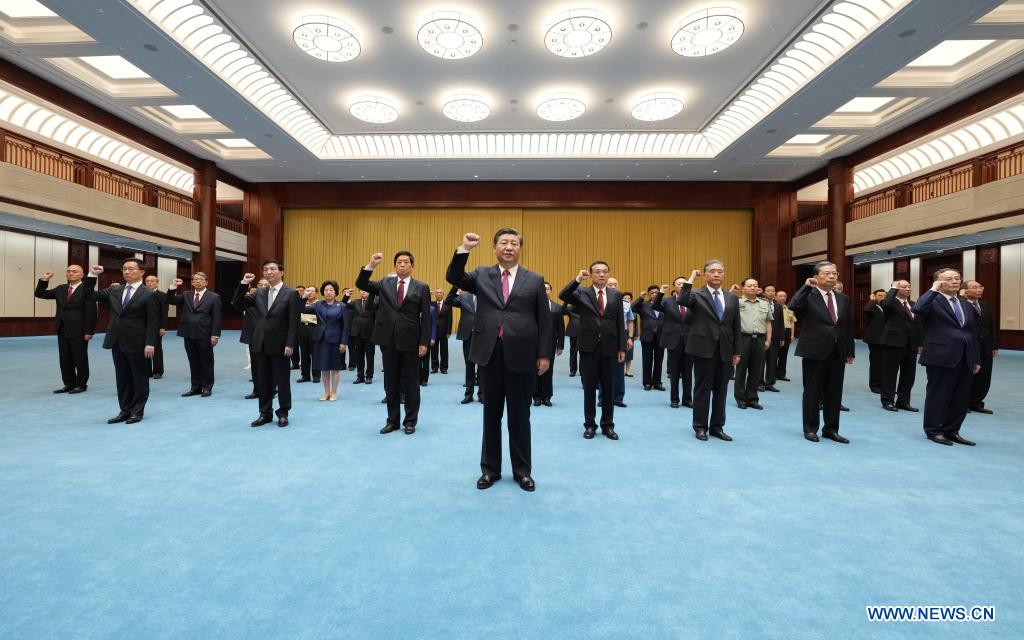Xi stresses drawing strength from CPC history to forge ahead
Xi Jinping leads other Communist Party of China (CPC) and state leaders Li Keqiang, Li Zhanshu, Wang Yang, Wang Huning, Zhao Leji, Han Zheng and Wang Qishan to review the Party admission oath after visiting an exhibition on CPC history themed "staying true to the founding mission" at the Museum of the CPC in Beijing, capital of China, June 18, 2021. (Xinhua/Li Xueren)
BEIJING, June 18 (Xinhua) -- Xi Jinping, general secretary of the Communist Party of China (CPC) Central Committee, on Friday stressed bearing in mind the course of the Party's struggles, shouldering the historic mission and drawing strength from the Party's history to forge ahead.
Xi, also Chinese president and chairman of the Central Military Commission, made the remarks when visiting an exhibition on CPC history.
Themed "staying true to the founding mission," the exhibition debuted on Friday at the newly inaugurated Museum of the CPC in Beijing ahead of the CPC centenary.
"The Party's history is the most vivid and convincing textbook," Xi stressed.
The past 100 years have seen the CPC unswervingly fulfilling its original aspiration and founding mission, working hard to lay a foundation for its great cause, and making glorious achievements and charting a course for the future, Xi noted.
Xi said it is necessary to study and review the Party's history, carry forward its valuable experience, bear in mind the course of its struggles, shoulder the historic mission, and draw strength from its history to forge ahead.
Efforts should be made to educate and guide Party members and officials to stay true to the original aspiration and founding mission of the Party, Xi noted.
It is necessary for them to strengthen their awareness of the need to maintain political integrity, think in big-picture terms, follow the leadership core, and keep in alignment with the central Party leadership, and remain confident in the path, theory, system and culture of socialism with Chinese characteristics, as well as always closely follow the CPC Central Committee in terms of their thinking, political orientation and actions, he added.
Xi called on Party members to carry forward the fine traditions and play their exemplary role in uniting and leading the Chinese people, based on the new development stage, to follow the new development philosophy and formulate a new development paradigm, to effectively perform their work in promoting reform, development and stability, and to pool strength to fully build a modern socialist China and realize the Chinese Dream of national rejuvenation.
Xi was joined by other leaders including Li Keqiang, Li Zhanshu, Wang Yang, Wang Huning, Zhao Leji, Han Zheng and Wang Qishan during the visit.
Led by Xi, the leaders reviewed the Party admission oath.
The exhibition features four parts, namely the founding of the CPC and the victory of the New Democratic Revolution; the founding of the People's Republic of China (PRC) and the socialist revolution and development; the reform and opening-up, and the start of socialism with Chinese characteristics; and carrying forward socialism with Chinese characteristics into a new era, building a moderately prosperous society in all respects, and embarking on a new journey toward fully building a modern socialist country.
More than 2,600 pictures and more than 3,500 pieces or sets of exhibits reflect the extraordinary 100-year journey the CPC has traveled.
Xi and other leaders immersed themselves in the exhibits, files, photos and videos displayed, and learned about them in detail.
Among the items are the manuscript of Karl Marx's notes from Brussels, and restoration scenes of the first CPC National Congress and the famous Zunyi Meeting during the epic Long March (1934-1936).
Also on display are boards showing the establishment of revolutionary bases, footage from the founding ceremony of the PRC, and weapons used during the War to Resist U.S. Aggression and Aid Korea (1950-1953).
The exhibition also features data charts relating to poverty alleviation and models of the Huoshenshan and Leishenshan hospitals built in Wuhan to fight the COVID-19 epidemic in 2020. Enditem
[ Editor: Zhang Zhou ]





More From Guangming Online
Medics from Fujian leave for Shanghai to aid in battle against COVID-19 resurgence
New int'l land-sea transport service to Indo-China Peninsula launched
Another makeshift hospital under construction in Shanghai
Tourists view tulips in Suiping County, Henan
In pics: blooming gagea flowers on grassland in Zhaosu, Xinjiang
Greek workers stage 24-hour general strike over high prices